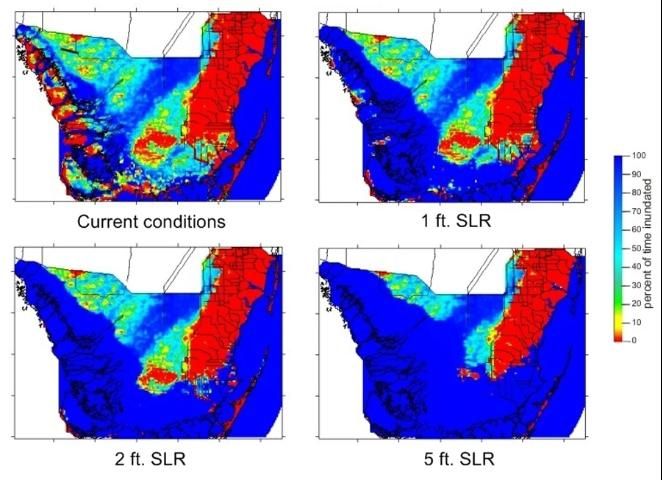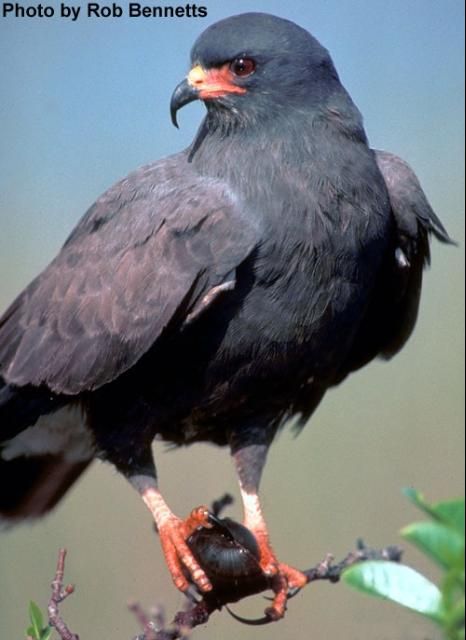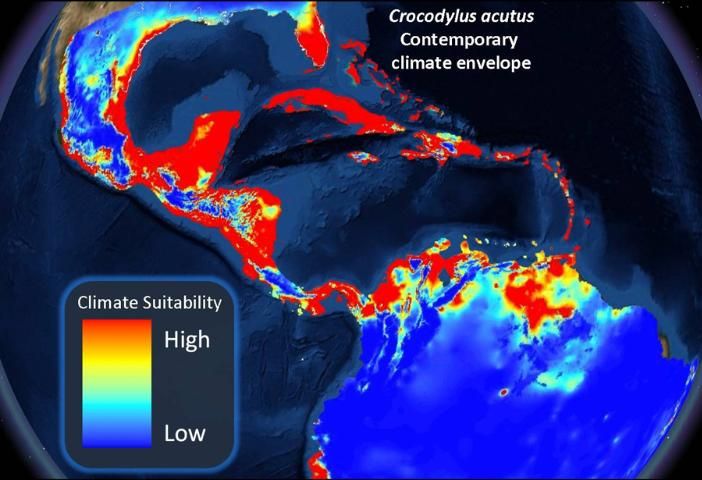A Conservation Challenge
Earth's changing climate is among the foremost conservation challenges of the 21st century, threatening to permanently alter entire ecosystems and contribute to extinctions of species. Lying only a few feet above sea level and already suffering effects of anthropogenic stressors, south Florida's ecosystems are particularly vulnerable to negative impacts of climate change. Recent research accounting for the gravitational effects of melting ice sheets predicts that sea level rise on US coastlines will be much higher than global averages (Gomez et al. 2010), and the Miami-Dade Climate Change Advisory Task Force predicts that local sea level rise will be at least 3 to 5 ft. (0.9 m to 1.5 m) by 2100 (MDCCATF 2008). In a 5 ft. scenario, up to 873 additional square miles of the Everglades would be inundated with saltwater (see maps below). Accelerated sea level rise is likely to be accompanied by increasing temperatures (IPCC 2007a) and more intense tropical storms and hurricanes (Webster et al. 2005). In addition, changes in amount, timing, and distribution of rainfall in south Florida may lead to more severe droughts and floods (SFWMD 2009).

Credit: Eric Swain, USGS, unpublished data
Mangroves that line the Everglades and Florida Bay are migrating landward in response to coastal saltwater intrusion, but this migration is only predicted to keep pace with sea level rise that is less than 1 ft. (0.3 m) over the next century (NPS 2009). Without a productive mangrove ecosystem, as sea level rises, saltwater will move inland resulting in inundation and loss of freshwater habitat. The Florida Keys are already experiencing effects of storm surge, overwash, and salinity encroachment, and increasing sea level rise could reduce the amount of habitat available to endangered species such as the Key deer (Odocoileus virginianus clavium) and silver rice rats (Oryzomys palustris natator). An increase in intensity of storms could further contribute to loss of habitat, destruction of natural barriers, and direct mortality of wildlife. For example, Hurricane Andrew, a category 5 storm, destroyed over 80% of the mangroves in the vicinity of Highland Beach in Everglades National Park (Smith et al. 1994).

Credit: John Oberheur, USFWS
With global average temperatures predicted to rise by 2° to 5.5°C by 2100 (IPCC 2007a), ecosystems will shift geographically and change in species composition. Differing phenological responses to climate change among taxonomic and functional groups may lead to loss of synchronization between animal species and their food sources (Parmesan 2007). Some migratory bird species are already responding to temperature changes by initiating migrations earlier (Cotton 2003), which may alter breeding habits and increase competitive interactions with resident bird populations (NPS 2009). Changing rainfall patterns as a result of climate change also threaten to disrupt nesting of wading birds and of the endangered Cape Sable seaside sparrow (Ammodramus maritimus mirabilis) (NPS 2009). Moreover, a decrease in precipitation could decimate populations of Florida apple snails (Pomacea paludosa), the primary prey of the endangered Everglades snail kite (Rostrhamus sociabilis plumbeus) (USFWS 1999). These examples of potential impacts on south Florida's ecology illustrate the serious and unprecedented challenge presented by climate change, a challenge that is galvanizing the conservation community to find new ways to help ecosystems adapt to an uncertain future.

Credit: Rob Bennetts, USGS
A Collaborative, Landscape-Scale Response
The U.S. Department of the Interior (DOI) is adapting its approach to the management of public lands to address impacts of climate change (USDOI 2009a). The Department is initiating renewable energy development on DOI lands and is proactively working to protect natural resources from the effects of climate change. Priorities include adjusting water management strategies to prevent flooding and ensure sufficient water supply, advancing carbon sequestration efforts, facilitating "state of the art" science on climate change impacts, and developing science-based adaptive management strategies for resource managers. The DOI recognizes that effective management responses must occur at the landscape level, necessitating a cooperative approach among state and federal agencies and other partners. Landscape Conservation Cooperatives (LCCs) provide a new structure of science partnerships to develop decision-support tools to address climate change and other landscape-scale stressors (USFWS 2009).
The U.S. Fish and Wildlife Service (FWS) was first among DOI's bureaus to develop a strategic plan to respond to climate change (USFWS 2009). The plan calls for "bold, aggressive action" within three focus areas: adaptation, mitigation, and engagement. Mitigation involves decreasing the Service's own carbon footprint and researching and developing carbon sequestration activities, and engagement focuses on collaboration and education of stakeholders and policymakers. Adaptation, the core of the plan, refers to actions that will help species and habitats adjust to climate change. FWS will facilitate science-based long-term conservation planning based on regional climate modeling and species and habitat vulnerability assessments. Adaptation goals and objectives also include taking immediate actions to protect vulnerable species, acquiring new lands to enhance quality and connectivity of habitat, and reducing other threats to ecosystems such as pollutants and invasive species. The development of LCCs will mobilize the scientific expertise needed to assemble data and develop modeling and statistical tools to guide adaptation decisions.

Credit: Larry Richardson, USFWS
Modeling the Future
DOI bureaus are applying an adaptive management framework to manage land and natural resources in the face of new challenges presented by climate change (USDOI 2009b). Adaptive management is a science-based system of learning designed to reduce uncertainty inherent in ecosystem management (Williams et al. 2007). As predictions about climate change impacts are continually being refined, adaptive management allows for continual incorporation of new information and responsive adjustment of management actions (USDOI 2009b). To support decision making in an adaptive management framework, new tools and methods are needed that can incorporate data on temperature, precipitation, sea level, and biotic responses to these changes. Managers need to understand which climate parameters are likely to change, what the magnitude of change may be, and how natural resources (e.g., species, habitats and ecosystems) are likely to respond.
To address the need for new, flexible decision-support tools, the University of Florida, FWS, U.S. Geological Survey, and National Park Service are working in partnership to develop climate envelope models for threatened and endangered species (see also UF/IFAS Publication WEC-282). Climate envelope models describe relationships between species' occurrences and bioclimate variables to define a species' climate niche (called an envelope), and then map the geographic shift of that envelope under climate change scenarios (IPCC 2007b). The climate envelope modeling project will identify critical limiting factors to species' distributions that are directly and indirectly influenced by climate change. The initial target species are 26 non-marine threatened and endangered vertebrate species that occur within the boundaries of the Peninsular Florida LCC. Multiple climate scenarios will be used to forecast potential shifts in species' climate envelopes. Output will be presented in an interactive mapping interface that will allow managers to evaluate climate change impacts on species for improved ecosystem and landscape planning.
Armed with data-driven models that articulate directional, quantifiable responses to climate change, managers striving to safeguard natural resources will be equipped to take specific, justifiable protective actions based on the best available information. On a regional level, the climate envelope models help to prioritize alternative management strategies (e.g., land acquisition, population monitoring) necessary to ensure protection of vulnerable species in the face of climate change. In addition to forecasted changes in climate envelopes, species' distributions will also be affected by changes in habitat resulting from sea level rise and development and by unpredictable species interactions. Thus, integrating results of climate envelope models with other research and modeling efforts that address habitat and land use change will provide the best projections to guide conservation and restoration planning. On a broader level, the climate envelope models and the collaborative approach used to develop them will result in a flexible framework that can apply to a wide variety of species across geographic scales, contributing to ongoing development of national strategies for assisting wildlife in adapting to climate change.

Credit: University of Florida, unpublished data

Credit: University of Florida, unpublished data
Literature Cited
Cotton, P. A. 2003. Avian migration phenology and global climate change. Proceedings of the National Academy of Sciences 100:13595–13599.
Gomez, N., J. X. Mitrovica, M. E. Tamisiea, and P. U. Clark. 2010. A new projection of sea level change in response to collapse of marine sectors of the Antarctic Ice Sheet. Geophysical Journal International 180:623–634.
Intergovernmental Panel on Climate Change (IPCC). 2007a. Climate change 2007: The physical science basis. Contribution of Working Group I to the Fourth Assessment Report of the Intergovernmental Panel on Climate Change. Ed by S. Soloman, D. Qin, M. Manning, Z. Chen, M. Marquis, K. B. Averyt, M. Tignor and H. L. Miller. Cambridge University Press: New York.
Intergovernmental Panel on Climate Change (IPCC). 2007b. Climate or environment envelope models. In: Impacts, Adaptation and Vulnerability. Contribution of Working Group II to the Fourth Assessment Report of the Intergovernmental Panel on Climate Change. Ed. by M. L. Parry, O. F. Canziani, J. P. Palutikof, P. J. van der Linden and C. E. Hanson. Cambridge University Press: New York. https://www.ipcc.ch/site/assets/uploads/2018/03/ar4_wg2_full_report.pdf. Accessed January 27, 2023.
Miami-Dade County Climate Change Advisory Task Force (MDCCATF). 2008. Statement on sea level rise in the coming century. In: Second Report and Initial Recommendations Presented to the Miami-Dade Board of County Commissioners. April 2008. https://www.miamidade.gov/environment/boards/climate-change-task-force.asp. Accessed January 27, 2023.
National Park Service (NPS). 2009. Potential Ecological Consequences of Climate Change in South Florida and the Everglades: 2008 Literature Synthesis. Resource Evaluation Report. SFNRC Technical Series 2009:1.
Smith, T. J. III, M. B. Robblee, H. R. Wanless, and T. W. Doyle. 1994. Mangroves, hurricanes, and lightning strikes. BioScience 44: 256–262.
South Florida Water Management District (SFWMD). 2009. Climate Change and Water Management in South Florida. Interdepartmental Climate Change Group. West Palm Beach, FL. November 12, 2009.
U.S. Department of the Interior (USDOI). 2009a. Addressing the impacts of climate change on America's water, land, and other natural and cultural resources. Secretary of the Interior Order No. 3289. Washington, D.C.
U.S. Department of Interior (USDOI) Task Force on Climate Change. 2009b. An analysis of climate change impacts and options relevant to the Department of Interior's managed lands and waters. A report of the subcommittee on land and water management. https://www.adaptationclearinghouse.org/resources/an-analysis-of-climate-change-impacts-and-options-relevant-to-the-department-of-the-interior-s-doi-s-managed-lands-and-waters.html
U.S. Fish and Wildlife Service (USFWS) 1999. Everglade Snail Kite (Rostrhamus sociabilis plumbeus). Multi-Species Recovery Plan for South Florida. Pages 4–291–4–324. https://www.fws.gov/verobeach/MSRPPDFs/EvergladeSnailKite.pdf
U.S. Fish and Wildlife Service (USFWS) 2009. Rising to the Challenge: Strategic Plan for Responding to Accelerating Climate Change. September 21, 2009 (Revised draft). http://www.fws.gov/home/climatechange/pdf/CCDraftStratPlan92209.pdf
Webster, P. J., G. J. Holland, J. A. Curry, and H. R. Chang. 2005. Changes in tropical cyclone number, duration, and intensity in a warming environment. Science 309: 1844–1846.
Whittle, A., D. S. Maehr, S. Fei, J. Cox. 2008. Global climate change and its effects on large carnivore habitat in Florida. Abstract in: Florida's Wildlife: On the Frontline of Climate Change.
Williams, B. K., R. C. Szaro, and C. D. Shapiro. 2007. Adaptive Management: The U.S. Department of the Interior Technical Guide. Adaptive Management Working Group, U.S. Department of the Interior, Washington, DC.